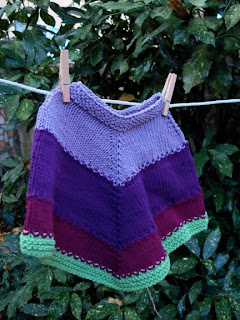 |
| The pattern is here. |
Ever since I became a knitting designer, I’ve had a dream of creating my own yarn line. Although there is a vast number and variety of yarns available, I wanted one that was a personal reflection of my love of colour and yarn qualities. With my background as an artist I knew the joy of picking up my paints and mixing any colour I could imagine. When my imagination turned to knitwear design, it seemed to me the ultimate achievement to create not just the garment or shawl, but also the actual yarn used to knit it. I’m sure that spinners feel the same way!
Over the past few years I have labeled a selection of yarns with the Fiddlesticks Knitting name, gradually increasing my input into the creation of the yarn content and colour, and learning about the process along the way. This year I finally achieved my goal of creating a yarn completely from my imagination, my “Enticing” line of luxury yarns. So how does one create a yarn?
I source my yarns through an agent who specializes in liaising with yarn mills. The mill where all my yarns are “born” is in Italy, the home of many beautiful, high-quality yarns. While I have not (yet!) visited the mill, my agent has and takes care of all the communication details. The steps involved are:
1. Visualize and specify the yarn content and weight.
I specialize in creating designs for lace knitting, including shawls, scarves and garments. I thought that a fingering weight yarn would be a perfect complement to the yarns already in my collection, giving me the flexibility to design practically anything! I could also double it to make garments in a DK weight, or mix single and double strands together in the same design.
In the past I worked with a lace weight mohair yarn and liked the slightly fuzzy halo it created, along with the soft, floaty quality. However, there are a number of very nice mohair lace weight yarns already in the marketplace. Looking for similar qualities, I decided to pursue an angora mix, combining it with merino wool and silk, the two other yarn components used in my current yarns, thereby giving a sense of consistency to the collection. As I couldn’t find a similar example in the marketplace, I knew that my yarn would be fairly unique.
At this point, the mill created a number of samples for me to test, using more or less of each of the three yarn components. After swatching and testing I selected a 70% merino, 20% angora and 10% silk blend. It gave what I considered the right amount of softness but retained good stitch definition. The bonus is the lovely “bloom” or soft halo that the angora brings to the mix, making a fabric that invites you to touch it.
 |
| The pattern is here. |
2. Create the colours.
The mill dyes yarn in minimum 30-kilogram lots (or 600 50-gram balls), combined with a minimum 300-kilogram yarn spin. This meant that I would create at least 10 colours for my new yarn. I love colour! So I splurged on 18 new colours, or a spin of 540 kilograms. I guess that’s one way to increase your yarn stash!
I decided that the colours should be soft, like the yarn, and not too bright or “pure.” I like colours that are complex and hard to describe, that don’t allow easy descriptions such as “yellow,” or “blue.” I gathered bits of yarn, fabric, paint samples, anything I could find that fit my ideas of colour. Then I laid them all out to confirm I had a palette that flowed together and fit my criteria. Bellissimo!
Then I put all the samples into individual bags by colour and sent them off to the agent to be forwarded to the mill. At the mill, sample dye dips were created with test spins of my yarn. These were returned to me for approval. It was an exciting day when this parcel arrived. Overall, I approved 15 colours immediately and sent back three for further trials, as being not quite what I had in mind. Once these were adjusted, I gave approval for all the colours, and the yarn spinning and dyeing was initiated.
3. Design the label.
In the meantime, I developed a yarn name and designed a label. This is where my former experience as a graphic designer came in handy, as I could do the label design myself using Illustrator. An eps file was forwarded to the mill for printing. |
| The pattern is here. |
4. Arrange the shipping.
Once the yarn was ready to be shipped to me, I chose a freight-forwarder here in Canada who handled my order from the dock in Italy to the customs clearance in Canada. Ultimately, a big truck pulled up at my door and 40 large boxes of yarn arrived, ready for a new life as beautiful hand-knitted shawls, scarves and sweaters!You can find the yarn on special until March 9th here. |
| Dorothy Siemens |

































